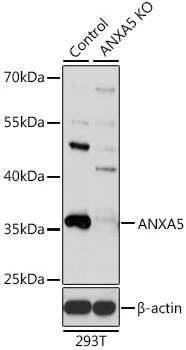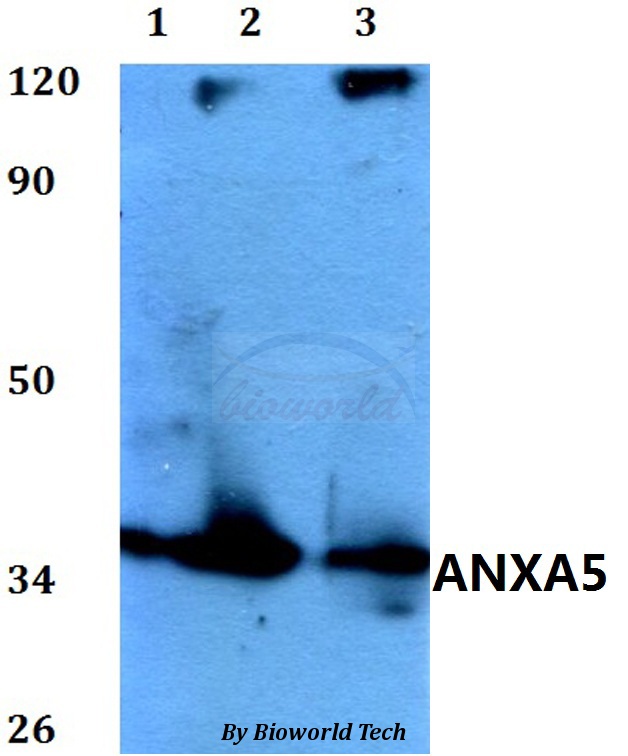Annexin V antibody
GTX103250
ApplicationsFlow Cytometry, Western Blot
Product group Antibodies
TargetANXA5
Overview
- SupplierGeneTex
- Product NameAnnexin V antibody
- Delivery Days Customer9
- Application Supplier NoteWB: 1:500-1:50000. FACS: 1:50-1:200. *Optimal dilutions/concentrations should be determined by the researcher.Not tested in other applications.
- ApplicationsFlow Cytometry, Western Blot
- CertificationResearch Use Only
- ClonalityPolyclonal
- Concentration1 mg/ml
- ConjugateUnconjugated
- Gene ID308
- Target nameANXA5
- Target descriptionannexin A5
- Target synonymsANX5, CPB-I, ENX2, HEL-S-7, PP4, RPRGL3, VAC-alph, annexin A5, CBP-I, PAP-I, VAC-alpha, anchorin CII, annexin V, annexin-5, calphobindin I, endonexin II, epididymis secretory protein Li 7, lipocortin V, placental anticoagulant protein 4, placental anticoagulant protein I, thromboplastin inhibitor, vascular anticoagulant-alpha
- HostRabbit
- IsotypeIgG
- Protein IDP08758
- Protein NameAnnexin A5
- Scientific DescriptionThe protein encoded by this gene belongs to the annexin family of calcium-dependent phospholipid binding proteins some of which have been implicated in membrane-related events along exocytotic and endocytotic pathways. Annexin 5 is a phospholipase A2 and protein kinase C inhibitory protein with calcium channel activity and a potential role in cellular signal transduction, inflammation, growth and differentiation. Annexin 5 has also been described as placental anticoagulant protein I, vascular anticoagulant-alpha, endonexin II, lipocortin V, placental protein 4 and anchorin CII. The gene spans 29 kb containing 13 exons, and encodes a single transcript of approximately 1.6 kb and a protein product with a molecular weight of about 35 kDa. [provided by RefSeq]
- Storage Instruction-20°C or -80°C,2°C to 8°C
- UNSPSC12352203
References
- Butts B, Goeddel LA, Zheng J, et al. Impact of early pericardial fluid chymase activation after cardiac surgery. Front Cardiovasc Med. 2023,10:1132786. doi: 10.3389/fcvm.2023.1132786Read this paper
- Sandau US, McFarland TJ, Smith SJ, et al. Differential Effects of APOE Genotype on MicroRNA Cargo of Cerebrospinal Fluid Extracellular Vesicles in Females With Alzheimer's Disease Compared to Males. Front Cell Dev Biol. 2022,10:864022. doi: 10.3389/fcell.2022.864022Read this paper
- Thangavel C, Boopathi E, Liu Y, et al. Therapeutic Challenge with a CDK 4/6 Inhibitor Induces an RB-Dependent SMAC-Mediated Apoptotic Response in Non-Small Cell Lung Cancer. Clin Cancer Res. 2018,24(6):1402-1414. doi: 10.1158/1078-0432.CCR-17-2074Read this paper
- Dong RF, Zhang B, Tai LW, et al. The Neuroprotective Role of MiR-124-3p in a 6-Hydroxydopamine-Induced Cell Model of Parkinson's Disease via the Regulation of ANAX5. J Cell Biochem. 2018,119(1):269-277. doi: 10.1002/jcb.26170Read this paper
- May EW, Lin ST, Lin CC, et al. Identification of up- and down-regulated proteins in doxorubicin-resistant uterine cancer cells: reticulocalbin-1 plays a key role in the development of doxorubicin-associated resistance. Pharmacol Res. 2014,90:1-17. doi: 10.1016/j.phrs.2014.08.007Read this paper
- Chen JY, Chou HC, Chen YH, et al. High glucose-induced proteome alterations in hepatocytes and its possible relevance to diabetic liver disease. J Nutr Biochem. 2013,24(11):1889-910. doi: 10.1016/j.jnutbio.2013.05.006Read this paper
- Ruggiero L, Connor MP, Chen J, et al. Diurnal, localized exposure of phosphatidylserine by rod outer segment tips in wild-type but not Itgb5-/- or Mfge8-/- mouse retina. Proc Natl Acad Sci U S A. 2012,109(21):8145-8. doi: 10.1073/pnas.1121101109Read this paper




